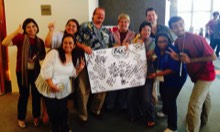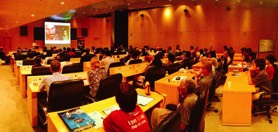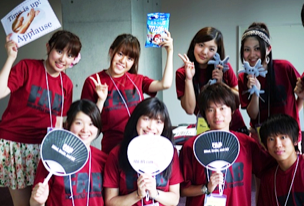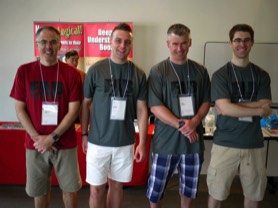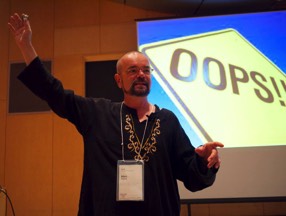
What does FAB mean? FAB is the acronym that we use for our conferences. Our very first conference was named “First Annual Brain day” — or FAB. The acronym has stuck.
As of 2014, FAB became a non-profit research organization (“Gakkai” in Japanese). Its Japanese name is NeuroELT 応用脳科学英語教育国際FAB学会
What is neuroELT? This is a new interdisciplinary field within the fields of Applied Linguistics and Educational Neuroscience. In a nutshell, it is at the convergence of neuroscience and English language teaching, thus “NeuroELT.”
The formation of our initiatives (FAB and neuroELT) is connected to the Mind, Brain, and Education program at the Harvard Graduate School of Education.
Our sister organization is the BRAIN SIG (Mind, Brain, And Education Special Interest Group) of JALT (Japan Association for Language Teaching). You can see them on Facebook too.
Previous FABs
Here are the previous FABs and some stories from the FAB Founders.
FAB1 Kitakyushu & Nishinomiya, Japan, 2011
FAB2 Sendai, Japan, 2012
FAB3 Kitakyushu, Japan, 2012
FAB4 Nagoya, Japan, 2013
FAB5 Kitakyushu, Japan, 2014
FAB6 Manila, Philippines, 2015
FAB7 Baguio, Philippines, 2015
FAB8 Kyoto, Japan, 2015
FAB9 Cebu, Philippines, 2016
FAB10 Macao, China, 2016
FAB Stories
The first FAB was held in 2011. Since it was right after the Tohoku earthquake, it became a charity event for Tohoku children, and held in two cities. Robert and Ai Murphy did almost all the work organizing this first conference. Curtis Kelly, Marc Helgesen, and Tim Murphey also played a part, and became “FAB Founders.” Joseph Shaules came on board a couple years later.
As of 2014, FAB became a non-profit research organization (“Gakkai” in Japanese). Its Japanese name is NeuroELT 応用脳科学英語教育国際FAB学会
What is neuroELT? This is a new interdisciplinary field within the fields of Applied Linguistics and Educational Neuroscience. In a nutshell, it is at the convergence of neuroscience and English language teaching, thus “NeuroELT.”
The formation of our initiatives (FAB and neuroELT) is connected to the Mind, Brain, and Education program at the Harvard Graduate School of Education.
Our sister organization is the BRAIN SIG (Mind, Brain, And Education Special Interest Group) of JALT (Japan Association for Language Teaching). You can see them on Facebook too.
Previous FABs
Here are the previous FABs and some stories from the FAB Founders.
FAB1 Kitakyushu & Nishinomiya, Japan, 2011
FAB2 Sendai, Japan, 2012
FAB3 Kitakyushu, Japan, 2012
FAB4 Nagoya, Japan, 2013
FAB5 Kitakyushu, Japan, 2014
FAB6 Manila, Philippines, 2015
FAB7 Baguio, Philippines, 2015
FAB8 Kyoto, Japan, 2015
FAB9 Cebu, Philippines, 2016
FAB10 Macao, China, 2016
FAB Stories
The first FAB was held in 2011. Since it was right after the Tohoku earthquake, it became a charity event for Tohoku children, and held in two cities. Robert and Ai Murphy did almost all the work organizing this first conference. Curtis Kelly, Marc Helgesen, and Tim Murphey also played a part, and became “FAB Founders.” Joseph Shaules came on board a couple years later.

Since I was a little kid, science was always the most important subject for me. It deeply fascinated me, so when I decided to become an English teacher and started graduate school, I was baffled with the lack of science in the literature. I found solace in the Mind, Brain, and Education program at the Harvard Graduate School of Education. It was there that Dr. Kurt Fischer showed me how to relate science with pedagogy—he’s been mentoring me ever since, and I can confidently say that Kurt’s work inspired me to co-found what we now call neuroELT. I hope to inspire others the way Kurt has inspired me.

I was always interested in neuroscience and I started doing JALT presentations on it at the turn of the century. I think I was pretty much the first, and it was kind of lonely. Then, in 2006, at the Kitakyushu JALT conference, I met another guy who was interested. Like me, it bothered him that there was so little neuroscience coming into ELT. After hours of talking in the basement of the Rhiga Royal Hotel, we swore a blood oath that we would change that. The guy? Robert Murphy, and five years later he, with Ai’s help, organized the first FAB conference to make the change happen. Marc and Tim came on board then too and the First Annual Brain (FAB) Day was a hit. It changed our lives.

About 10 years ago, I started seeing the connection between Positive Psychology and ELT. I started studying it, learning more, experimenting, writing activities, doing presentations, built a website, etc. Psychology has come a long way since Freud's couch (and even farther from his cigar). It is about the brain, replicable studies, massive surveys, etc. - real brain science. When Robert and Ai Murphy put together the first FAB, I was delighted to get involved. We finally had a group of people who wanted to discuss and learn about these things.

In graduate school, I became deeply interested in the work of Edward Hall, who wrote about the powerful, yet hidden influence of culture on our minds. This led me to an interest in cognition, deep culture, and language learning. We are starting to understand neurocognitive processes well enough to look for answers to questions Edward Hall started asking 50 years ago. Hall inspired me to see language and cultural learning as an opportunity for growth and transformation. I'm happy to be a part of the FAB community that shares similar passions.

When Robert came back from Harvard University in 2008, his mind was on the verge of exploding. He had finally found reliable ideas for language teaching methods based on neuroscience. He explained so many things to me and I also started to apply them in my classroom. Since then, my teaching has radically changed. My little students' responses have changed. Parents’ attitudes towards English learning have changed. Everyones’s learning became easier, funnier, and more efficient. My students are now enjoying using English not only in the classroom but also outside of the classroom, which is unusual in Japan. On a personal level, I'm interested in food education in the language classroom. Food is the fuel for our brains; eating well helps raise cognitive efficiency. Bad food choices lower efficiency. But, if children and parents learn how to make better food choices, it really helps learning — and makes teaching easier, too. I am now hooked on applying brain science in language teaching -- I hope you will get hooked, too!
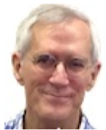
I was obsessed with sports as a child; school hurt! Ai, Robert, Curtis, Marc, and Joseph have all wonderfully organized the FAB conferences and presented wonderful ways to make learning not only painless, but exciting! There is a huge neuro-educational paradigm shift that this group is a part of, shifting us from “drill and kill” to “socialize, belong, play, and thrill” through healthy dopamine rushes, in and out of the classroom! We are learning crucial strategies to change education and involve learners in experiences that we think will get them obsessed with healthy learning and well-being, with healthy doses of positive psychology and cultural understandings that neuroscience makes more rigorously attainable. I am stoked and grateful to be a small part of these neuro-adventures. And we have only just begun!
